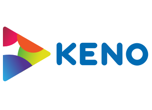Keno
Keno is Australia’s biggest lottery. It’s a social game available to play at most clubs and bars across the country.
As a designer working on this project, I needed to solve various user scenarios and design problems to create the best possible interfaces and experiences for the app and website.
The views in this case study are my own and do not represent Keno or any of their brands.

Role: Product UX/UI Designer
Project: iOS apps and website design
Year: 2015
Scroll ↓

Overview.
Keno is a well-known game that has been in Australia for many years. When I began the project, the app and website were quite dated and needed a user experience and interface design overhaul. The goal was to refresh the website and iOS app taking into consideration business and customer needs. We built the new products from the ground up. Initially, we worked closely with some great designers from Fjord and then eventually took the project into our own internal team’s hands for completion and release.
Tool Stack.

Process.
When we started the project, we held a full day inception and design workshop with the key stakeholders in Sydney and Melbourne. We covered the vision of Keno and prioritised features that the products required. From these sessions, we created an initial strategy and an overview of the user experience requirements. From that point onwards we worked in Agile scrum teams running with 2 week sprints.

Business Priorities.
To understand what the business needed we held regular meetings and presentations with them in the Sydney, Melbourne offices and online. Later in the project, I was travelling to Melbourne to work with the business and hand over to the team we had assembled there.
Research.
We looked at historical data and created personas based on what we found. These personas were a great reference throughout the project and helped guide us in a clear direction. Some of the other research involved monitoring and interviewing people in venues while testing equipment range and geo functionality for digital in retail experiences and signage.
Project Management.
For Keno, we used Mingle as our main digital point of controlling and monitoring the tasks in the project. To go with the Mingle we also created a physical Kanban board with swimming lanes and task cards. The tasks were sized by members of the team with the help of our Scrum Master using Fibonacci and t-shirt sizing. Once this was done they were captured in both areas.
Wireframes & User Testing.
For Keno, we sketched wireframes in sharpies and pencils on paper before moving onto simple digital versions that we made in Sketch. This was great to quickly create and discuss ideas with the team. Once we liked an idea we created clickable prototypes in InVision and tested with our user and customer base in lab style setting taking videos of them and the screens with pre-written scripts. If the idea worked it would then take make it to the UI design stage.

Interface Design.
To begin with, we created the style guides of the apps and websites. This contained our colours, icon styles, grid structure, simple illustrations and typography. This document was essential to maintain consistency across all the platforms. We created custom icons and illustration to appear in the products, we created these in Sketch and Adobe illustrator. Once we had created the styleguide in Sketch we began building out the concepts into final UI designs that were ready to be developed.




Feedback.
Keno was released successfully throughout Australia in 2016. We celebrated our hard work with launch parties in Sydney and Melbourne. The customer feedback has been great and more people than ever are using the responsive website and native iOS App. The business is pleased with the result and has seen a 5% yearly increase in revenue since refreshing Keno.

Selected Projects
© Julio Castellano 2018






